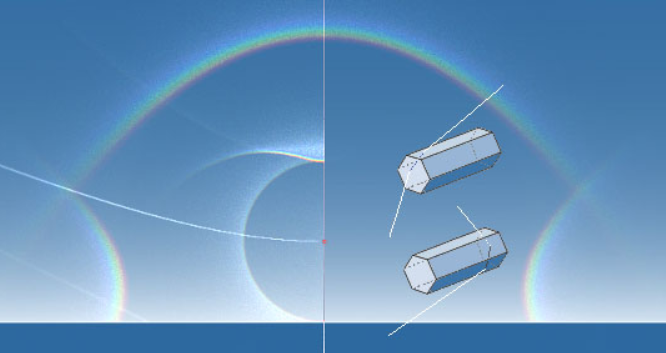Supralateral & Infralateral Arcs
Supralateral & Infralateral Arcs: A Colorful Phenomenon in the Sky
Supralateral and infralateral arcs are captivating atmospheric optics phenomena that occur when rays of light pass between the side and basal faces of hexagonal ice crystals. These arcs exhibit vibrant colors and are usually observed only as fragments. They undergo significant shape transformations as the position of the sun changes throughout the day.
The supralateral arc, akin to the circumzenithal arc, exclusively forms when the solar altitude is below 32°. It appears as an upper arc in the sky and can be challenging to distinguish from the 46° halo, leading to many reported cases of misidentified supralateral arcs as halos.
To better understand these intriguing arcs, let's delve into their characteristics and how they are formed:
Formation of Supralateral and Infralateral Arcs
-
Hexagonal Ice Crystals: Supralateral and infralateral arcs arise from the interaction of sunlight with hexagonal ice crystals suspended in the atmosphere. These crystals have a preferred orientation, with their long axes aligned horizontally.
-
Passage of Light: When sunlight enters the hexagonal crystal, it can pass through either the side face or the basal face. Rays that traverse through the basal face contribute to the formation of supralateral and infralateral arcs.
-
Isolation of Arcs: By filtering out rays that have passed through an end face, a simulation can isolate the supralateral (upper) and infralateral (lower) arcs. This isolation allows for a clearer observation and analysis of these arcs.
Characteristics of Supralateral and Infralateral Arcs
-
Fragmented Appearance: Supralateral and infralateral arcs are typically observed as fragments rather than complete circles. Their appearance is subject to change depending on the altitude of the sun.
-
Vibrant Colors: These arcs exhibit vivid colors due to the scattering and refraction of sunlight within the ice crystals. The colors can range from reds and oranges to blues and purples.
-
Dynamic Shape: The shape of supralateral and infralateral arcs can undergo dramatic transformations as the position of the sun changes throughout the day. These changes contribute to the complexity and allure of these atmospheric phenomena.
Differentiating Supralateral Arcs from Halos
-
Similarities with the 46° Halo: Small sections of supralateral arcs can be challenging to distinguish from the 46° halo. Consequently, many reported instances of 46° halos are likely misidentified supralateral arcs.
-
Solar Altitude: Supralateral arcs form exclusively at solar altitudes below 32°. By considering the altitude of the sun, observers can differentiate between supralateral arcs and other atmospheric optical phenomena.
In conclusion, supralateral and infralateral arcs are captivating atmospheric optics phenomena that arise from the interaction of sunlight with hexagonal ice crystals. These arcs exhibit vibrant colors and dynamic shapes, adding to the visual allure of the sky. Understanding their formation and characteristics allows us to appreciate the complexity and beauty of these atmospheric phenomena. So, keep an eye on the sky, and you might just catch a glimpse of these mesmerizing arcs!

Colourful supralateral and infralateral arcs form when rays pass between the side and basal (end) faces of singly oriented hexagonal columns.
The filtered right hand simulation shows only rays which have passed through an end face and so isolates the supralateral (upper) and infralateral (lower) arcs. The unfiltered simulation at left also has a bright upper tangent arc and parhelic circle produced by the same column crystals. Some poorly oriented crystals were added to make the 22° The filtered right hand simulation shows only rays which have passed through an end face and so isolates the supralateral (upper) and infralateral (lower) arcs. The unfiltered simulation at left also has a bright upper tangent arc and parhelic circle produced by the same column crystals. Some poorly oriented crystals were added to make the 22° halo.
These brightly coloured arcs are usually seen only as fragments. They change their shapes dramatically with changes in solar altitude. The supralateral arc, like the related circumzenithal arc, only forms at solar altitudes below 32°.
Small sections can be difficult to distinguish from the 46° halo and most of the 46° halos reported are probably supralateral arcs. halo.
These brightly coloured arcs are usually seen only as fragments. They change their shapes dramatically with changes in solar altitude. The supralateral arc, like the related circumzenithal arc, only forms at solar altitudes below 32°.
Small sections can be difficult to distinguish from the 46° halo and most of the 46° halos reported are probably supralateral arcs.
Note: this article has been automatically converted from the old site and may not appear as intended. You can find the original article here.
Reference Atmospheric Optics
If you use any of the definitions, information, or data presented on Atmospheric Optics, please copy the link or reference below to properly credit us as the reference source. Thank you!
-
<a href="https://atoptics.co.uk/blog/supralateral-infralateral-arcs/">Supralateral & Infralateral Arcs</a>
-
"Supralateral & Infralateral Arcs". Atmospheric Optics. Accessed on December 22, 2024. https://atoptics.co.uk/blog/supralateral-infralateral-arcs/.
-
"Supralateral & Infralateral Arcs". Atmospheric Optics, https://atoptics.co.uk/blog/supralateral-infralateral-arcs/. Accessed 22 December, 2024
-
Supralateral & Infralateral Arcs. Atmospheric Optics. Retrieved from https://atoptics.co.uk/blog/supralateral-infralateral-arcs/.